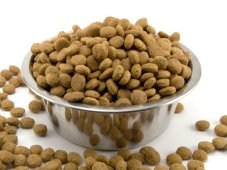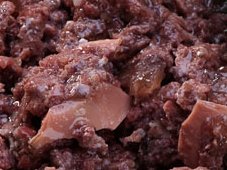Prebiotics Support Your Dog’s Inner Strength

Your dog’s immune system works to combat these invaders, and dog food with ingredients called "prebiotics" can now strengthen that defense. Prebiotics are non-digestible food ingredients that stimulate the growth and activity of digestive-system bacteria that are beneficial to your dog’s health. For the first time, they are now available in both wet and dry high-quality dog foods. Dr. Amy Dicke, an Ohio-based veterinarian, explains more about what prebiotics are and how they work.
Prebiotics in Dog Food
While certain dog foods now have the word "prebiotics" on the front label, check the product’s ingredient list. Look for the long word "fructooligosaccharides," or FOS for short. Foods with this word have one of the best prebiotics now available. Although the name seems very scientific, it actually refers to a fiber, according to Dicke. "FOS is found naturally in certain fruits, vegetables and grains," she explains. "However, the concentration is typically very low and does not provide the desired health benefits."
How Prebiotics Work
Sixty-five percent of your dog’s immune system is in its digestive tract. To infect your dog’s body, germs and other invaders must break through a mucous membrane barrier of cells lining the gut. Like a wall, this barrier can prevent unwanted organisms from moving into the body.
When FOS is broken down, it produces short-chain fatty acids, which serve as food or energy for the cells of the mucosal barrier, promoting their health and integrity. An increasing population of beneficial bacteria help to crowd out bad bacteria through physical competition for space and nutrients, as well as producing substances detrimental to the undesirable bacteria.
Health Benefits of Prebiotics
Beyond supporting the immune system, prebiotics may also lead to other health benefits in your dog. Research on humans, who use prebiotics in a similar way, found that prebiotics appear to reduce inflammation. "Just as some foods can lead to poor health, it’s no surprise that others can have positive effects," said Dr. Louis Montaner, editor of the Journal of Leukocyte Biology, which recently published a study on prebiotics.
Prebiotics have also been shown to cut the development of skin alergies in human babies. A study in the journal Archives of Disease in Childhood reported that prebiotics – very similar to those found in breast milk – ward off a dangerous form of dermatitis. Puppies receive comparable prebiotics from their mothers when they nurse, so it’s possible that prebiotics in dog food help prevent skin and coat problems in adult dogs.
How to Begin Feeding a Dog Food Containing Prebiotics
If your dog is not currently eating a food that contains prebiotics and you’d like to make the switch, there should be a transition period of mixing the new food with your dog’s current diet. Here’s a sample feeding schedule over a week’s time:
- Day 1 and 2: Feed approximately one-fourth of new food mixed with three-fourths of current food.
- Days 2 and 3: Mix half of old food with half of new food.
- Days 4 to 6: Give your dog three-fourths of the new prebiotics-containing food and one-fourth of its former chow.
- Day 7: Begin feeding your dog 100 percent of the new product.
Are Prebiotics Suitable for All Dogs?
According to Dicke, prebiotics can be beneficial to nearly all dogs. "There are times during your pet’s life when dietary FOS may even have greater value," she added. Dogs that may especially need the immunity boost of prebiotics include:
- Weaned puppies with developing immune systems
- Dogs with certain chronic medical conditions
- Pregnant females
- Older dogs that may suffer from decreased immune system function
Consult with your veterinarian to see what he or she recommends. If your dog has a serious weight or medical condition, it might require a special veterinarian formula food to address its particular needs.













